Quarantine flip flop unleashes pandemic of confusion, frustration

TOO CLOSE FOR COMFORT Jeepney commuters in Makati City keep a measured distance between them after the government reduced the standard 1-meter rule for distancing on public vehicles. INQUIRER file photo / NIÑO JESUS ORBETA
MANILA, Philippines—Two days ago, on Sept. 7, the government backpedaled and surprised the public by deciding to postpone the implementation of localized lockdowns as Metro Manila shifts to general community quarantine (GCQ).
Metro Manila was supposed to shift to GCQ starting Sept. 8 to 30, as the government imposes what officials termed as “granular” lockdown with a four-level alert system which will determine businesses and activities allowed certain areas.
Under the new lockdown system, local government units will only restrict the movement of residents in small areas—either a specific building, street, zone, village, and other places where there are high cases of COVID-19.
READ: MMDA: ‘Alert level’ status to be used in granular lockdowns
Instead, Metro Manila and other areas will remain on modified enhanced community quarantine (MECQ) status until Sept. 15
READ: NCR stays under MECQ until Sept. 15; pilot granular lockdown deferred
The decision, however, was met with criticism by small business owners and some government officials, too.
Article continues after this advertisementWas it wise to extend MECQ?
Article continues after this advertisementAmid rising COVID-19 cases in the country, paired with threats of the more transmissible Delta variant, some said Metro Manila is not yet ready for the lenient GCQ and a new lockdown system.
However, the flip-flop on quarantine status caused confusion and frustration among business owners and workers.
READ: Gov’t like boy who cried wolf in flip-flop on quarantine status – business group
Joblessness during MECQ
The last time Metro Manila was placed on MECQ, from April 12 to May 14, 2021, the country’s unemployment rate was 8.7 percent in April and 7.7 percent in May, according to Philippine Statistics Authority’s (PSA) labor force survey (LFS).
PSA explained that employment rate in April dropped to 91.3 percent from 92.9 percent in March when ECQ and MECQ were imposed in Metro Manila and nearby areas.
The unemployment rate in Metro Manila alone last April was 14.4 percent for individuals aged 15 years old and over who were active in the labor market.
Although unemployment rate eased in May, there were still 3.73 million Filipinos who were left jobless.
READ: More Filipinos employed in May but jobless number—3.73M—still high
According to PSA, these sectors suffered drastic cuts in employment in April 2021:
- Water supply industry (including sewerage, waste management, and remediation activities): 0.8 percent or around 346 of the total 43,269 employed persons in April from around 408 employed persons in March.
- Construction industry: 52.5 percent or 22,716 employed persons from around 25,477 employed persons in March.
- Wholesale and retail trade (including jobs involving repair of motor vehicles and motorcycles): 39.7 percent or 17,178 employed persons from around 18,405 employed persons in March.
- Information and communication: 1.5 percent or 649 employed persons from around 816 employed persons in March.
- Financial and insurance activities: 2.4 percent or 1,039 employed persons from around 1,224 employed persons in March.
- Human health and social work activities: 2.4 percent or 1,039 employed persons from around 1,179 employed persons in March.
- Arts, entertainment and recreation: 1.1 percent or 476 employed persons from around 589 employed persons in March.
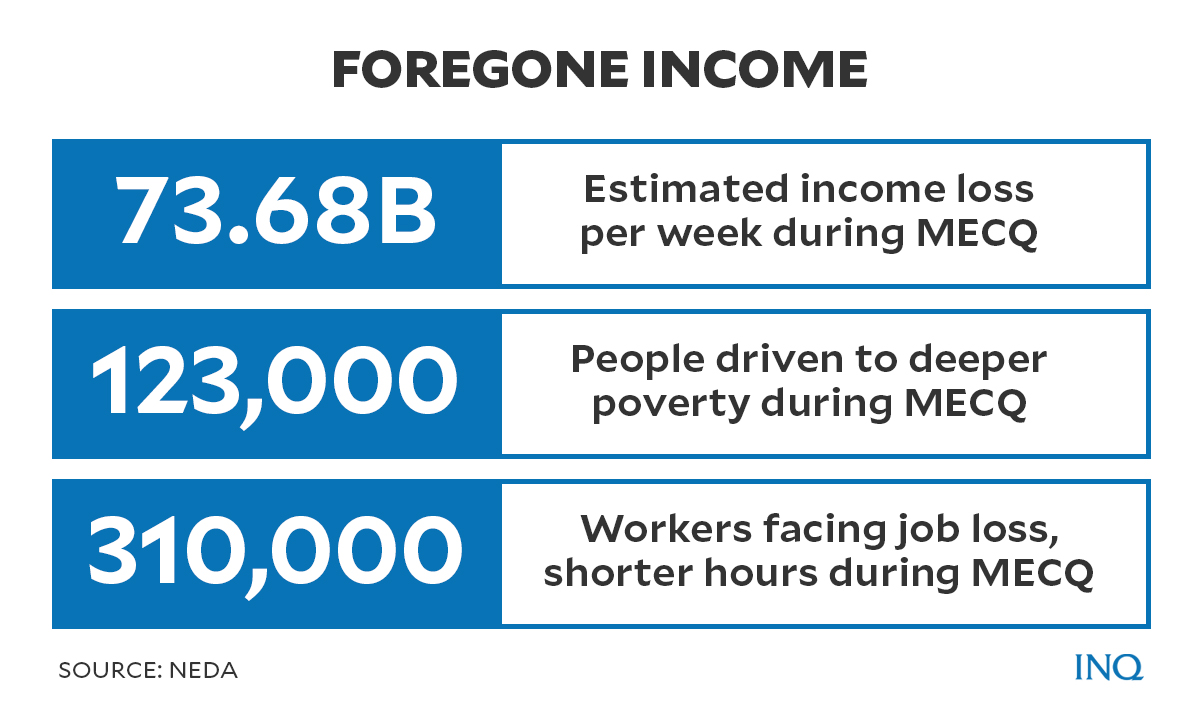
Graphic by Ed Lustan
Meanwhile, in May, the following sectors had lower employment rates compared to those in April including:
- Fishing and aquaculture: Around 10.7 percent or 4,785 out of 44,716 total employed persons in May from 5,538 during the previous month.
- Mining and quarrying: 1.5 percent or 671 employed persons from around 1,039 employed persons in April.
- Electricity, gas, steam, and air conditioning supply: 0.7 percent or 313 employed persons from around 389 employed persons in April.
- Professional, scientific, and technical activities: 0.9 percent or 402 employed persons from around 476 employed persons in April.
- Administrative and support service activities: 5.9 percent or 2,638 employed persons from around 3,029 employed persons in April.
- Education: 5.8 percent or 2,594 employed persons from around 2,639 employed persons in April.
- Human health and social work activities: 2.3 percent or 1,028 employed persons from around 1,039 employed persons in April.

Graphic by Ed Lustan
In 2020, the International Labour Organization (ILO) estimated that at least one-fourth of the Philippines’ total labor force, or at least 10.9 million workers, was likely to face displacement due to the pandemic.
This can take the form of income declines, reduced working hours or complete joblessness.
ILO’s report on COVID-19’s impact on the Philippine labor market said at least 7.8 million workers, the most in unemployment figures, were at risk of displacement due to the pandemic in these sectors:
- Transportation and storage
- Accommodation and food services
- Wholesale and retail trade
- Construction
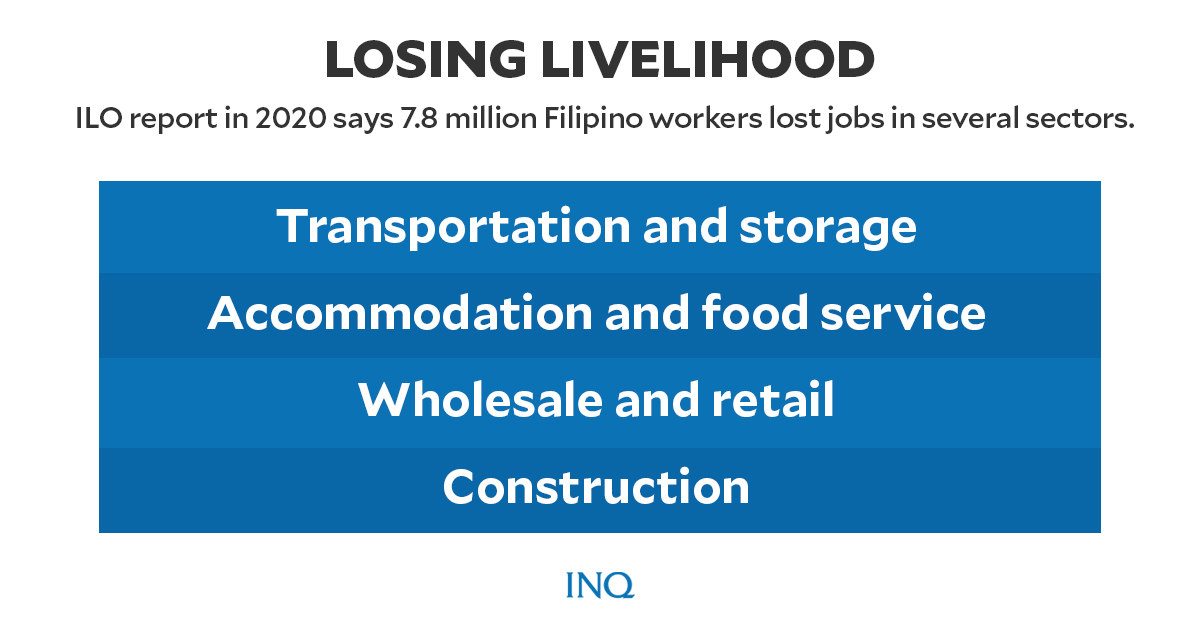
Graphic by Ed Lustan
The first two sectors—including arts, entertainment, and recreation—had been tagged by ILO as high risk and were “least likely to remain operative” due to quarantine restrictions. These were also likely to suffer from sharp slumps in demand during the pandemic, ILO said.
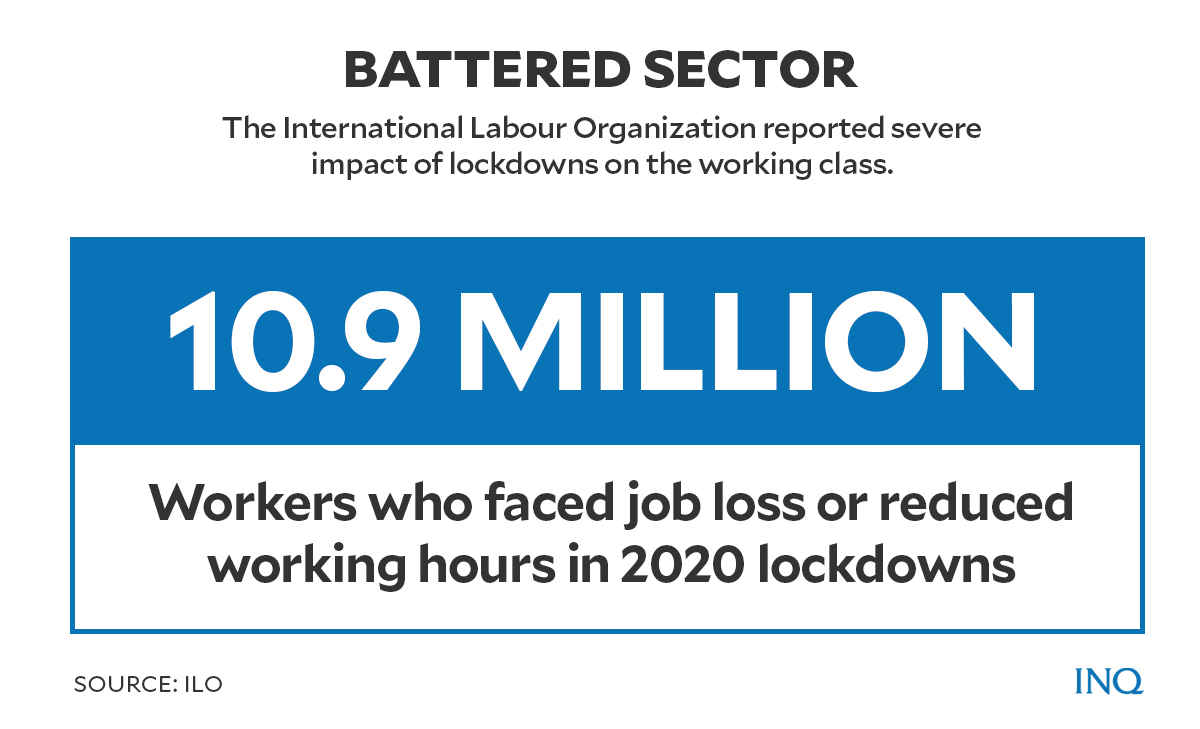
Graphic by Ed Lustan
The organization also listed several sectors that were at medium risk of job displacements or suspension of operations:
- Water supply and waste management and construction
- Wholesale and retail trade
- Information and communication
- Finance and insurance
- Real estate
- Professional and science
ILO said these sectors may still recover after a transition period.
Impact on businesses
Estimates by the National Economic Development Authority (NEDA) showed that the country’s economic losses under MECQ modified enhanced community quarantine (MECQ) could reach P73.68 billion in foregone output per week.
The number of poor people was likely to grow by 82,000 to 123,000 and displaced workers could reach 310,000.
“In other words, our imposition of quarantine does not come without costs — there are severe economic costs, and that is why our position is to manage this risk so that we can open the economy at the appropriate time,” said Socioeconomic Planning Secretary Karl Kendrick Chua.
READ: Neda: It may take up to 2023 before PH economy returns to pre-pandemic output
Last April, Trade Secretary Ramon Lopez said that the country could lose P120 billion under a three-week MECQ.
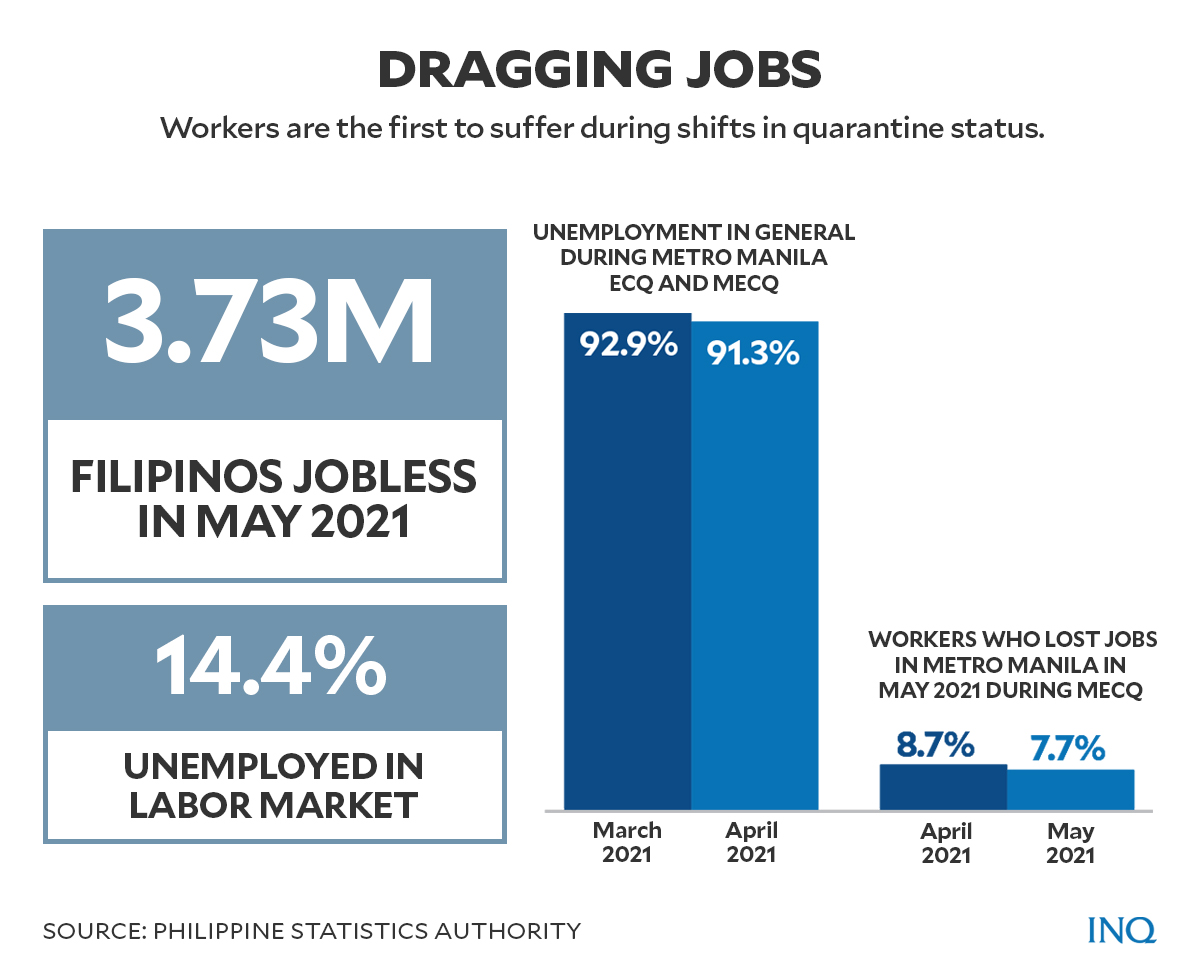
Graphic by Ed Lustan
In terms of income loss, Chua estimated that people lost at least P83.3 billion in five weeks under enhanced community quarantine (ECQ) and MECQ.
Based on guidelines issued by the Inter-Agency Task Force (IATF) for the management of emerging infectious diseases, the following businesses are prohibited to operate under MECQ:
- Barbershops and salons
- Gyms/fitness studios and sports facilities
- Entertainment industries (cinema, theaters, karaoke bars)
- Kid amusement industries (playrooms, rides)
- Libraries, archives, museums, and cultural centers
- Tourist destinations (water parks, beaches, resorts)
- Travel agencies, tour operators, reservation service and related services
- Personal care services (massage parlors, sauna, facial care, waxing, etc.)
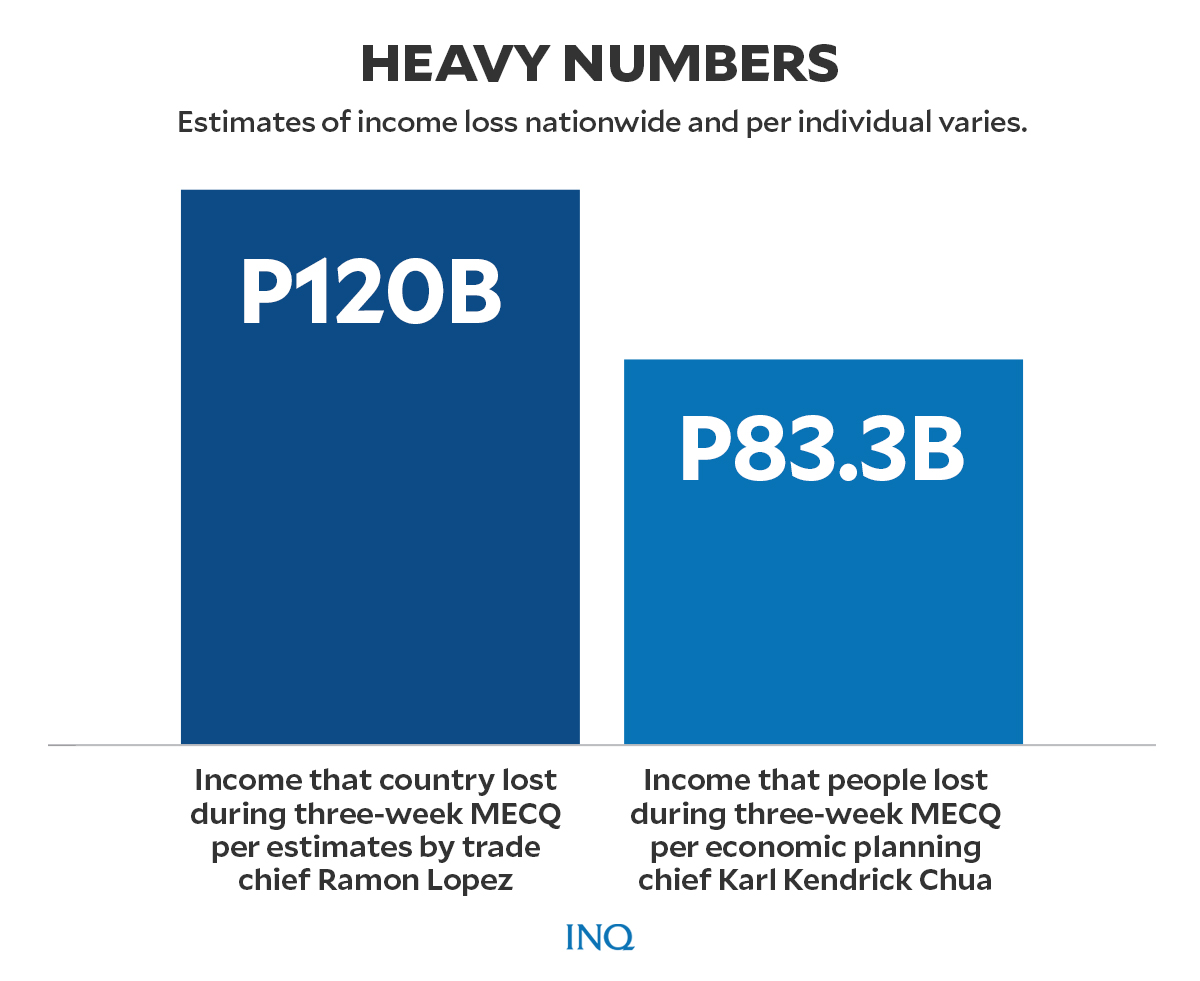
Graphic by Ed Lustan
Other businesses and sectors are allowed to operate with 50 percent of workers on site and 50 percent working from home.
READ: LIST: Businesses allowed to resume operations in MECQ areas
Small businesses struggle
In a now-deleted viral Facebook post, business owner Inchang Mendoza shared her frustrations after the government suddenly announced the reimplementation of MECQ.
According to the post, her store staff already had general cleaning and bought kilos of meats to prepare for the expected shift to GCQ on September 8.
“Dear government, maawa naman kayo sa mga taong sobrang naapektuhan [na] nagtratrabaho ng maayos!” the post read.
This is on you, IATF.
This is on you, Duterte government. pic.twitter.com/yoKqVMrSaz— ChatJPT (@dumidyeypee) September 7, 2021
Smaller businesses in the country, according to studies, suffered heavier during the pandemic.
In a paper published last February, the Tokyo-based Asian Development Bank Institute (ADBI) said at least 75 percent of micro, small, and medium-scale (MSMEs) enterprises in the Philippines did not survive the first few weeks of the pandemic and were forced to close for good.
READ: ADB think tank: PH MSMEs need targeted support to survive prolonged pandemic
In a survey conducted from March to April 2020, ADB senior economist Shigehiro Shinozaki and statistician Lakshman N. Rao found that “education, construction, accommodation and food services (represented by tourism), and manufacturing were the hardest hit sectors in sales and revenue.”
“By region, MSMEs in the NCR were more likely to have no sales than those in the provinces,” the study said.
“However, MSMEs with declining revenue were more evident outside the NCR. Provincial MSMEs cut employees more than those in the NCR,” the study added.
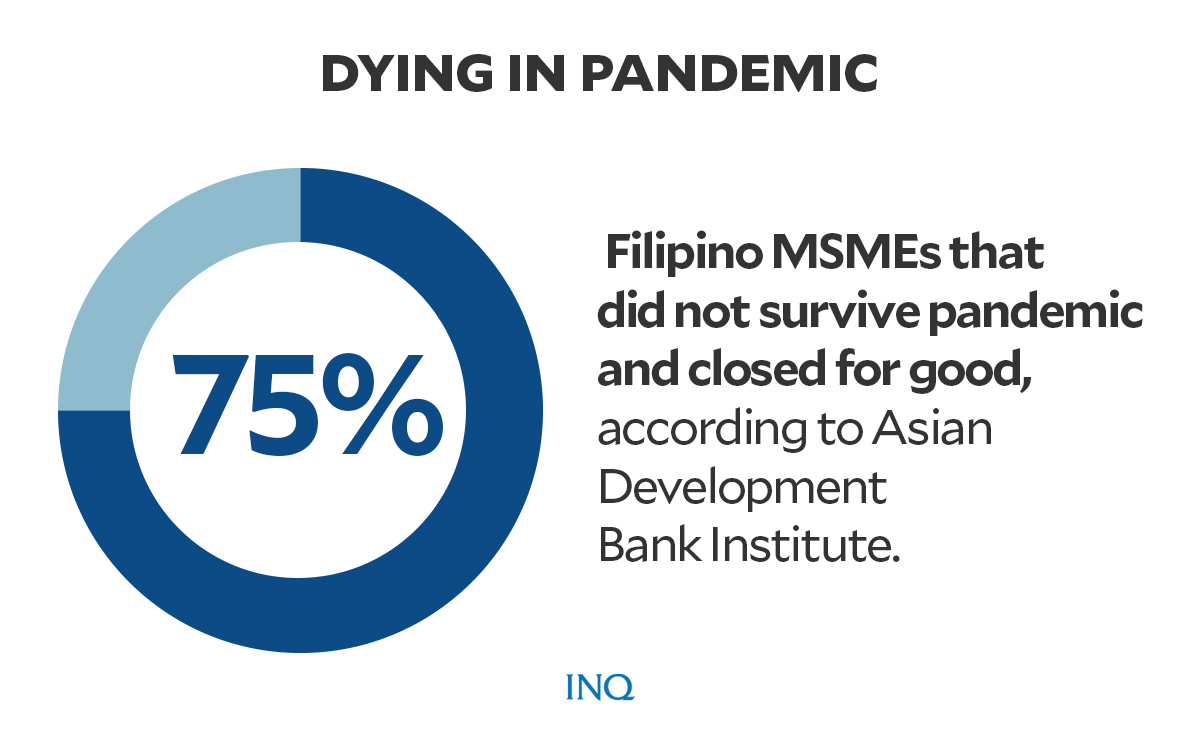
Graphic by Ed Lustan
Shinozaki and Rao likewise noted that young firms, that are operating for only five years or less, were immediately hit by the lockdowns in 2020—causing zero sale and business closures.
Vaccine progress
Last month, the Department of Health (DOH) said more individuals in Metro Manila were able to receive jabs of vaccine against coronavirus despite the ECQ, which was supposed to prevent people from going out.
According to Health Undersecretary Myrna Cabotaje, the daily average of administered shots increased from 151,000 during the pre-ECQ period to 168,000 during the ECQ implementation.
The increase was attributed to the public’s growing acceptance of vaccines out of fear of the more contagious coronavirus variant, Delta, and local government efforts to scale up injections.
However, Dr. Rafael Castillo, dean emeritus and lead faculty for research of the Fame Leaders’ Academy, said the government is “sabotaging its own efforts to curb the current outbreak [of COVID-19 cases]” by imposing lockdowns amid the ongoing vaccine drive.
“[W]e’re conducting mass vaccinations in a not too well-organized manner, with hundreds and thousands congregating, making these vaccination centers superspreader venues,” said Castillo, who also writes a column for the Inquirer.
READ: Gov’t ‘sabotaging own efforts’ with vax drive during lockdown – doctor
Vaccine czar Carlito Galvez Jr. on Sept. 9 said the government has administered a total of 37,176,513 doses of COVID vaccines.
Over 15 million Filipinos are also now fully vaccinated against COVID, he said.
READ: Over 15.8 million Filipinos now fully vaccinated vs COVID-19
Same safety measures
Under MECQ, all residents are required to observe minimum public health standards at all times. This includes wearing a mask and face shield, physical distancing, frequent sanitation, and other health protocols.
The movement of people in MGCQ areas is limited to accessing essential goods and services, work in offices or industries, and other activities permitted to continue.
Persons below 15 years old, senior citizens or those over 65 years old, those with immunodeficiency, comorbidity, or other health risks, and pregnant women are required to stay home at all times.
“Local government units may relax the minimum age range down to fifteen (15) years old, depending on the COVID-19 situation in their respective jurisdictions,” IATF said.
Meanwhile, individual outdoor activities like outdoor walks, jogging, running, or biking are allowed only within the general area of residences or within the barangay, subdivision, or village — still observing health and safety protocols.
Any gatherings outside of residences shall be prohibited.
“Gatherings at residences with any person outside of one’s immediate household shall likewise be prohibited,” the implementing agency stated.
“However, gatherings that are essential for the provision of health services, government services, or humanitarian activities authorized by the appropriate government agency or instrumentality shall be allowed,” it added.
Aside from these guidelines, the national and local government — alongside the health department — are encouraging people to get vaccinated against coronavirus.
Lesson learned?
Amid the criticisms that following the government’s abrupt decision to retain MECQ instead of pushing through with the new lockdown system, NTF Against COVID-19 spokesperson Restituto Padilla, Jr. admitted that the government lacked preparation.
“Maybe next time, as a lesson learned by the government, the guidelines should be prepared before making announcements,” he said, speaking in Filipino.
Still, Padilla said the government’s last-minute decision could be seen in a “positive light.”
“It is possible [that there was a lack in preparation]. [Another reason] was the call of the health workers to delay [the implementation of new lockdown system],” he said.
TSB
For more news about the novel coronavirus click here.
What you need to know about Coronavirus.
For more information on COVID-19, call the DOH Hotline: (02) 86517800 local 1149/1150.
The Inquirer Foundation supports our healthcare frontliners and is still accepting cash donations to be deposited at Banco de Oro (BDO) current account #007960018860 or donate through PayMaya using this link.